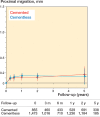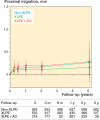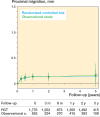Migration patterns of acetabular cups: a systematic review and meta-analysis of RSA studies
- PMID: 38157007
- PMCID: PMC10757199
- DOI: 10.2340/17453674.2023.24580
Migration patterns of acetabular cups: a systematic review and meta-analysis of RSA studies
Abstract
Background and purpose: We conducted a systematic review and meta-analysis of RSA studies to investigate the early and long-term migration patterns of acetabular cups and the influence of implant factors on cup migration over time.
Methods: We performed a systematic search of PubMed, Embase, and Scopus databases to identify all RSA studies of cup migration following primary total hip replacement (THR). Proximal migration at 3 and 6 months, 1, 2, 5, and 10 years were considered for analysis. Implant factors investigated included fixation type, head size, bearing surface, uncemented coating design, and the decade of RSA introduction.
Results: 47 studies reported the proximal migration of 83 cohorts (2,328 cups). Besides 1 threaded cup design, no implant factor investigated was found to significantly influence proximal migration. The mean pooled 2-year proximal migration of cemented cups (0.14 mm, 95% confidence interval [CI] 0.08-0.20) was not significantly different from uncemented cups (0.12 mm, CI 0.04-0.19). The mean pooled proximal migration at 6 months was 0.11 mm (CI 0.06-0.16) and there was no significant increase between 6 months and 2 years (0.015 mm, CI 0.000-0.030). 27 of 75 cohorts (36%) reported mean proximal migration greater than 0.2 mm at 2 years, which has previously been identified as a predictor of implants at risk of long-term loosening.
Conclusion: Our meta-analysis demonstrated that the majority of cup migration occurs within the first 6 months. With one exception, no implant factors influenced the 2-year proximal migration of acetabular cups. 36% of studies with 2-year migration were considered at risk of long-term loosening. Further investigation and comparison against long-term survivorship data would validate 6-month and/or 1-year proximal migration measurements as an earlier predictor of long-term loosening than the current 2-year threshold.
Figures










Similar articles
-
High early migration of the revised acetabular component is a predictor of late cup loosening: 312 cup revisions followed with radiostereometric analysis for 2-20 years.Hip Int. 2015 Sep-Oct;25(5):471-6. doi: 10.5301/hipint.5000246. Epub 2015 Apr 27. Hip Int. 2015. PMID: 25952912
-
Increased migration of uncemented acetabular cups in female total hip arthroplasty patients with low systemic bone mineral density. A 2-year RSA and 8-year radiographic follow-up study of 34 patients.Acta Orthop. 2016 Feb;87(1):48-54. doi: 10.3109/17453674.2015.1115312. Epub 2015 Nov 16. Acta Orthop. 2016. PMID: 26569616 Free PMC article.
-
[Influence of the Type of Hip-Component Fixation and Age of Patients on Mid-Term Revision Rate of Total Hip Replacement].Acta Chir Orthop Traumatol Cech. 2018;85(1):46-53. Acta Chir Orthop Traumatol Cech. 2018. PMID: 30257769 Slovak.
-
Acetabular Component Migration Measured Using Radiostereometric Analysis Following Revision Total Hip Arthroplasty: A Scoping Review.JBJS Rev. 2020 Apr;8(4):e0170. doi: 10.2106/JBJS.RVW.19.00170. JBJS Rev. 2020. PMID: 32304493
-
The efficacy of dual-mobility cup in preventing dislocation after total hip arthroplasty: a systematic review and meta-analysis of comparative studies.Int Orthop. 2019 May;43(5):1071-1082. doi: 10.1007/s00264-018-4062-0. Epub 2018 Jul 21. Int Orthop. 2019. PMID: 30032356
Cited by
-
Polyethylene wear and cup migration of cemented total hip arthroplasty with femoral heads made of oxidized zirconium, steel, or cobalt chromium: a 10-year secondary analysis from a randomized trial using radiostereometry.Acta Orthop. 2024 Sep 30;95:578-585. doi: 10.2340/17453674.2024.41945. Acta Orthop. 2024. PMID: 39347798 Free PMC article. Clinical Trial.
-
Provocation CT-Based Analysis for Diagnosis of Hip and Knee Arthroplasty Aseptic Loosening: Where Are We at? A Systematic Review of Clinical Trials.J Clin Med. 2025 Jul 9;14(14):4865. doi: 10.3390/jcm14144865. J Clin Med. 2025. PMID: 40725558 Free PMC article. Review.
-
Highly Porous Tantalum Acetabular Components Without Ancillary Screws Are Non-inferior at 7 Years When Compared With Titanium Components With Ancillary Screw Fixation: A Randomized Controlled Trial.Arthroplast Today. 2025 May 17;33:101709. doi: 10.1016/j.artd.2025.101709. eCollection 2025 Jun. Arthroplast Today. 2025. PMID: 40485814 Free PMC article.
-
Early cup migration and wear as predictors for later aseptic loosening: a secondary evaluation of a randomized controlled RSA trial on cemented hip arthroplasties with 18-year follow-up.Acta Orthop. 2025 Aug 15;96:618-624. doi: 10.2340/17453674.2025.44328. Acta Orthop. 2025. PMID: 40814981 Free PMC article. Clinical Trial.
-
Functional and Radiographic Outcomes of Custom Acetabular Implants for Severe Acetabular Defects: A Trauma Unit Perspective.Cureus. 2025 Jun 29;17(6):e86987. doi: 10.7759/cureus.86987. eCollection 2025 Jun. Cureus. 2025. PMID: 40734845 Free PMC article.
References
-
- AOANJRR . Australian Orthopaedic Association National Joint Replacement Registry Annual Report 2022. Adelaide: Australian Orthopaedic Association; 2022.
-
- LROI . LROI annual report 2022. Netherlands: Dutch Arthroplasty Register; 2022.
-
- Pijls B G, Nieuwenhuijse M J, Fiocco M, Plevier J W, Middeldorp S, Nelissen R G, et al. . Early proximal migration of cups is associated with late revision in THA: a systematic review and meta-analysis of 26 RSA studies and 49 survival studies. Acta Orthop 2012; 83(6): 583-91. doi: 10.3109/17453674.2012.745353. - DOI - PMC - PubMed
Publication types
MeSH terms
LinkOut - more resources
Full Text Sources
Medical

